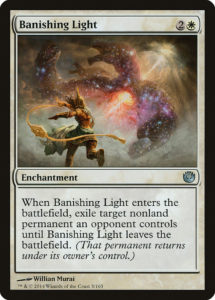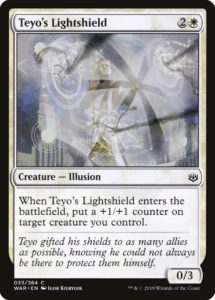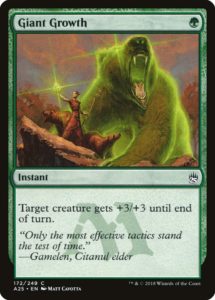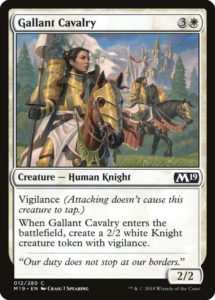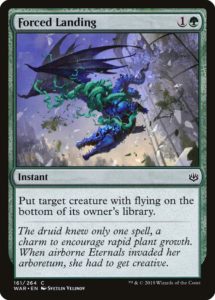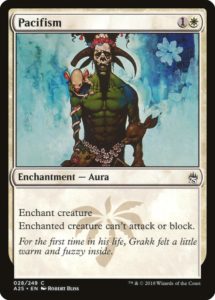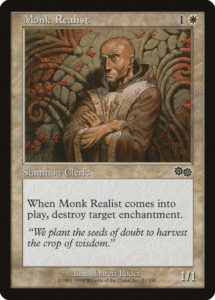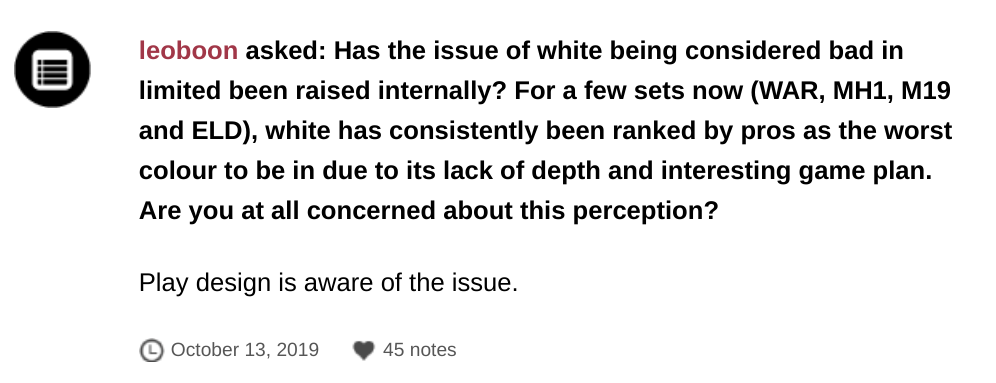For the past few years, white has ranked among the worst colors in practically every Limited environment. It has often suffered this indignity alongside green, but green has not matched white’s consistently dismal performance.
Today, we’ll examine the root causes of this issue as well as possible fixes that could be implemented—or, given Wizards’ time frame for developing sets, solutions that may have been implemented last year that we’ll be seeing next year. However, to properly evaluate white’s current status, let’s begin by asking what white is supposed to be good at.
What are white’s strengths and weaknesses?
White is the jack-of-all-trades color—it has access to some of the most versatile interaction and a large number of abilities, but there are fewer things that it alone does best. White has Pacifism and Prison Realm—strong answers, but answers that can be undone with the right cards. It has strong cheap creatures, especially one and two drops—white is the only color that regularly gets a 3/1 (sometimes with mild upside) for two mana. White is one of the best colors at producing tokens and making anthem effects to pump its team. Finally, white has access to powerful fliers alongside blue and has access to a wide swath of keywords: lifelink, vigilance, first strike, and double strike.
White’s biggest weakness is that it has access to little card flow. As it has the most versatile toolbox, it’s the color for which card draw is both most essential and most dangerous. White can also struggle when its creatures get invalidated—while red has reach and most other colors (especially green) have massive creatures to overpower the opposition, white mostly lacks these tools (excepting higher-rarity cards like angels).
What happened?
White was once top dog in Limited, or at least in the middle of the pack. White/green human aggro was one of the stronger archetypes in Innistrad. Windsteed Rider plus Hopeful Eidolon was a devastating combo in Theros. In Khans of Tarkir white fell in Abzan and Mardu, two of the stronger clans, and had one of the best commons in Feat of Resistance.
I’d argue that the problems began around the beginning of the Two Block Paradigm with Battle for Zendikar. While green was by far and away the worst color, and Grixis colors were the best because they had exclusive access to a major set theme (a trend that will be repeated). White only had one consistently strong strategy: WB lifegain allies. A year later, white was at the bottom of the barrel for both Kaladesh and Aether Revolt (its removal was weak and ineffective against many vehicles and its creatures were often lackluster). White was fine in Amonkhet and had access to a variety of strategies (zombies/exert/go wide/embalm).
Perhaps the nosedive began with 2017’s Ixalan. Territorial Hammerskull was one of the best commons, but white’s small or defensive creatures had a difficult time racing alongside it. GW and RW dinosaurs had almost no synergy, white provided few vampires synergies when paired with black, and WU was an unsupported color pair.
Rivals of Ixalan slowed the format and helped balanced the scales with cards like Exultant Skymarcher, Legion Conquistador (which improved in a much smaller set), and Squire’s Devotion. White also regained a full four supported color pairs. But in the next set, Dominaria, white again had thin synergy, some of the worst Kicker cards, and a slew of mediocre commons beyond the easily splashable Blessed Light and the outstanding Pegasus Courser.
On Ravnica, white’s decline continued. White Boros was strong in Guilds, Selesnya was by far the weakest and white’s non-Mentor commons were generally poor. White was so much more dangerous to commit to than the Grixis colors, because a Boros deck often couldn’t fall back into a Selesnya deck. Ravnica Allegiance seemed like a good set for white, but it rode the coattails of strong guilds—Orzhov and Azorius (with splashes). White’s monocolor commons were anemic compared to the other colors. And in War of the Spark, white and green were once again locked in combat to determine which was more inferior to the Grixis colors.
Core Set 2020 continued white’s downward trend despite the return of Pacifism, one of the best white common removal spells ever. And now white in Throne of Eldraine doesn’t look impressive compared to what the other colors can do.
So, what’s happened? Each color spends time at the top and bottom of the totem pole, but why has white sunk so far? Well, there are several trends that have happened over the past decade.
Creature size
White is supposed to have incredibly strong one and two mana creatures, then it begins losing market share to green as you go up the creature curve. However, it isn’t difficult to invalidate one and two mana creatures wholesale in Limited, often simply by playing a 2/3. Furthermore, creatures have been steadily getting better over time. Red and black now access to 2/2s for two with no downside—which neither had before 2012—making them better at competing with white at the low end of the curve. Green now regularly gets 3/3s for three and 4/4s for four with upside, and even competes with white’s dominance at the two-drop slot with cards like Garruk’s Companion. Even blue has gotten in on the action, receiving cards like Wishful Merfolk that can trade with a huge percentage of white’s three drops. We’ve also seen more cards like Wishcoin Crab and Sporecap Spider that single-handedly invalidate a majority of white’s common creatures, yet aren’t even high picks.
White also lags behind at the top of the curve, with its power usually topping out at three. Every other color has access to 4+ power creatures at common. If you look at each color through all of Magic’s history, blue has 56 common creatures with 4+ power, black has 79, red has 125, green has 172, and white has four. War of the Spark had the perfect example of this disparity of the top of the curve: compare Bulwark Giant with Kiora’s Dambreaker, Tithebearer Giant, Invading Manticore, and Primordial Wurm—white is the only color that’s likely to trade down on mana and without getting card advantage.
There are a couple possible patches to this primary problem:
Buff white’s creatures. If everyone other color is getting better two drops, maybe it’s time for white to get a two mana 3/2, or more 3/1s with upside (like Daring Skyjek)? Maybe white can get bigger finishers than a five mana 3/4 flying? There is danger here, since this could exacerbate the power creep we’ve seen at common, especially because tiny tweaks on small numbers are drastic tweaks (going from 1 to 2 toughness is a 100% boost). Ideally, we’d avoid giving white lots of Gust Walkers (creatures that are nearly impossible to block or race effectively).
Debuff nonwhite creatures. Perhaps red, black, and blue have improved too quickly relative to white and need to be toned down a bit? This is the less exciting tweak (since it’s akin to taking away toys), but perhaps this could be accomplished by printed fewer cheap creatures with 4+ toughness. If a 2/4 is unassailable by white creatures without combat tricks, perhaps they shouldn’t be so readily available.
Tokens
A second consequence of nonwhite creatures getting bigger is that the value of tokens has diminished. A 1/1 token still costs about 1-1.5 mana to make and a 2/2 token still costs 2 mana, just as it did last decade. You’re getting less bang for your buck because token costs haven’t been adjusted for inflation. It’s too easy to invalidate extra 1/1s and 2/2s with a 1/3 or 2/3, and every color is often getting those with upside for two and three mana.
There are several possible solutions:
Recost tokens. Maybe a 1/1 should actually cost 0.75 mana instead of a full mana? Raise the Alarm is a powerful Magic card when it has synergies or powerful equipment but in isolation a pair of 1/1s is weaker than a single 2/2 (and a 2/2 for two isn’t even that good anymore).
More tokens with keywords. Flying and lifelink are strong abilities on tokens. If tokens are a bit cheaper, we could perhaps see a Sworn Companions at two mana or a Midnight Haunting at common (although instant speed token making can be akin to removal with possible card advantage).
More rewards for tokens. Tokens need payoffs to reward getting smaller creatures. This could be mechanics that improve creatures (like Mentor), stronger tribal interactions with tokens, more Sanctified Charges and fewer Charges to reward going wide, and more powerful sacrifice outlets.
Flying is worse
Because creatures have been getting more mana efficient over time but flying still adds a whole mana to a creature’s cost, flying is weaker. Moreover, while blue has been getting 3/4 flying creatures for five mana with upside like Watcher in the Mist, Cloudreader Sphinx, Boreal Elemental); white is stuck with Prized Griffin, Enforcer Griffin, and Shining Aerosaur. Wind Drake isn’t that powerful anymore, and while Pegasus Courser is a huge boon for white, it suffers when white’s offense is anemic.
Perhaps it’s time for white to start getting Mistral Charger or a common 4/2 flying for five to help finish games. (Fun fact: there has never been a common 4/2 flying creature. The closest we’ve come is Steeple Creeper.)
Removal
It wasn’t that long ago that Pacifism was among the best commons in every set. While it’s still quite powerful, it has lost a lot of stock along the way. Part of this is due to blue and green now consistently getting access to quality creature removal. Pacifism is simply less important when there are redundant effects. The other issue is that colors increasingly have access to abilities that undermine Pacifism-style effects. When blue gets strong bounce spells, black has sacrifice outlets, red has activated abilities, and green gets main-deckable Naturalizes, there’s much greater risk for enchantment-based removal.
White also has access to spells that unconditionally exile, but they tend to cost five mana, making them among the most expensive removal spells. This high cost is justified by power level, but as the other colors’ removal and threats improve, this rate gets worse.
We could experiment with white getting Oblivion Strike, but I think it’d be dangerous to change white’s removal (which is already pretty solid). Making white’s creatures a bit better (and denying it fewer set shenanigans that Grixis accesses exclusively) would already make its potent removal strong enough, since it could be deployed to aggressively remove dangerous creatures rather than eliminate troublesome blockers.
White is a tricky color to balance. When it has good creatures and removal, it can dominate Limited. But with mediocre creatures and fine removal, it consistently lags behind. Magic is a better game when all five colors are vying for dominance and a worse game when one color consistently lags behind.
Interestingly enough, this article was well in development when MaRo wrote the following:
It’s good to know that this issue is well known to Wizards (and presumably has been known to Play Design for some time internally). I’m excited to see how and how soon they reacted to this data. Hopefully we’ll be both pleased to see some anticipated changes as well as surprised by some unexpected and welcome tweaks. Only time will tell. Until then, white’s got some waiting to do.
And, as always, thanks for reading.
—Zachary Barash is a New York City-based game designer and the commissioner of Team Draft League. He designs for Kingdom Death: Monster, has a Game Design MFA from the NYU Game Center, and does freelance game design. When the stars align, he streams Magic (but the stars align way less often than he’d like).
His favorite card of the month is Heraldic Banner. It combines mana ramp/fixing (which normally controlling and goodstuff decks want) with a color-specific anthem (which is what monocolor aggressive decks want). There’s a lot of power there, but it presents a deckbuilding puzzle for players to find a solution to. It’s also the perfect kind of puzzle to include in Throne of Eldraine, since the format is defined by finding balance among ambitious monocolor mana requirements. And okay, it also works perfectly with Unlikely Alliance.

